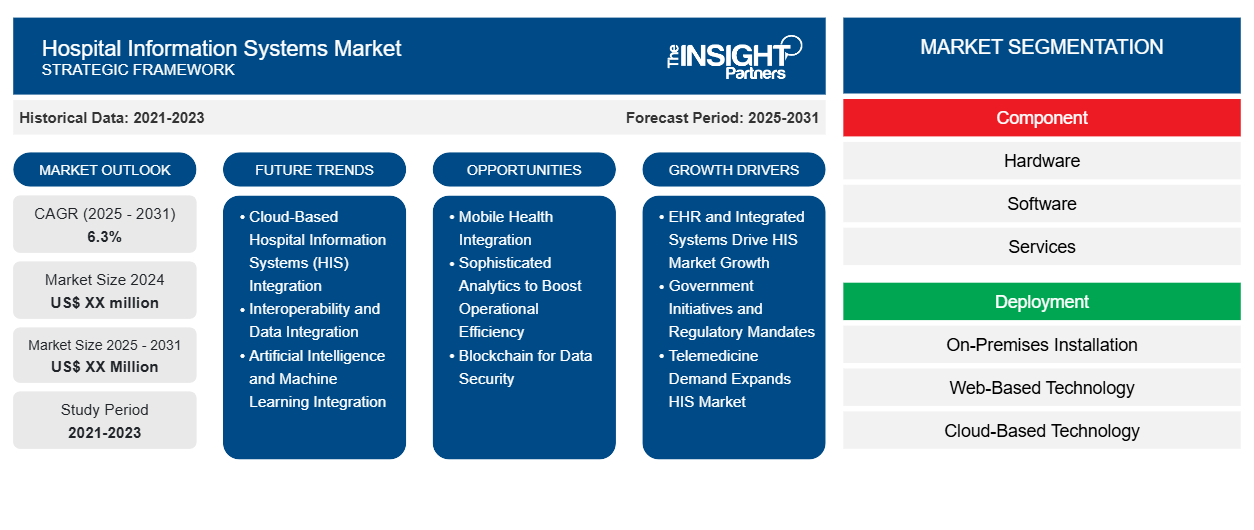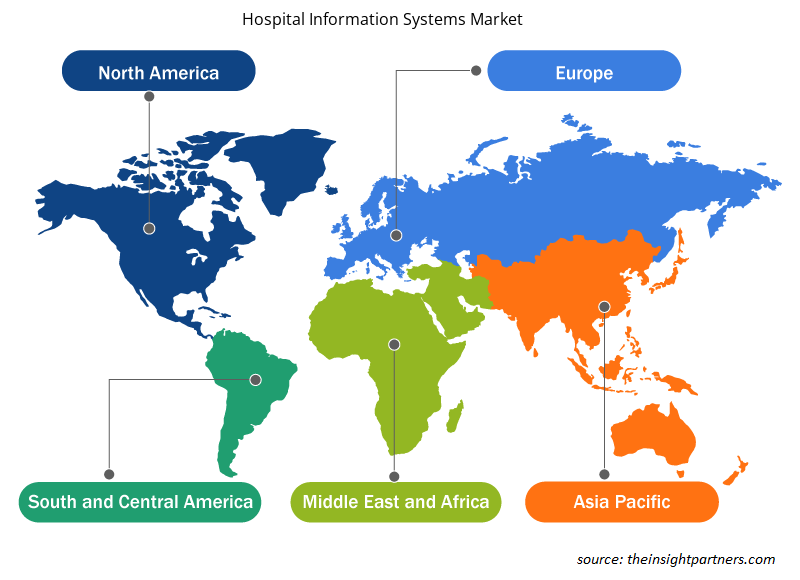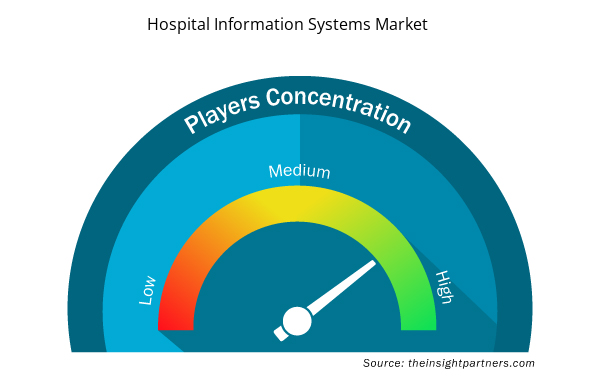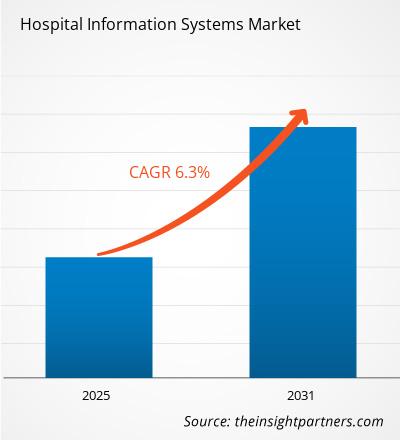Le marché des systèmes d'information hospitaliers devrait enregistrer un TCAC de 6,3 % de 2025 à 2031, avec une taille de marché passant de XX millions USD en 2024 à XX millions USD d'ici 2031.
Le rapport sur le marché des systèmes d'information hospitaliers offre une vue d'ensemble mondiale et régionale du marché. Il propose également une analyse segmentaire par composant, déploiement, type de système et utilisateurs finaux. L'étude de marché présente les stratégies commerciales adoptées par les principaux acteurs.
Objet du rapport
Le rapport sur le marché des systèmes d'information hospitaliers, publié par The Insight Partners, vise à décrire le paysage actuel et la croissance future, les principaux moteurs, les défis et les opportunités. Il fournira des informations aux différents acteurs du secteur, notamment :
- Fournisseurs/fabricants de technologies : pour comprendre l’évolution de la dynamique du marché et connaître les opportunités de croissance potentielles, leur permettant de prendre des décisions stratégiques éclairées.
- Investisseurs : réaliser une analyse complète des tendances concernant le taux de croissance du marché, les projections financières du marché et les opportunités qui existent tout au long de la chaîne de valeur.
- Organismes de réglementation : Réglementer les politiques et les activités de police sur le marché dans le but de minimiser les abus, de préserver la confiance des investisseurs et de maintenir l’intégrité et la stabilité du marché.
Segmentation du marché des systèmes d'information hospitaliers
Composant
- Matériel
- Logiciel
- Services
Déploiement
- Installation sur site
- Technologie basée sur le Web
- Technologie basée sur le cloud
Type de système
- Système d'information clinique
- Système d'information administrative
- Dossier médical électronique
- Système d'information de laboratoire
- Système d'information radiologique
- autres
Utilisateurs finaux
- Hôpitaux
- Les compagnies d'assurance
- autres
Personnalisez ce rapport en fonction de vos besoins
Vous bénéficierez d'une personnalisation gratuite de n'importe quel rapport, y compris des parties de ce rapport, ou d'une analyse au niveau des pays, d'un pack de données Excel, ainsi que de superbes offres et réductions pour les start-ups et les universités.
Marché des systèmes d'information hospitaliers : perspectives stratégiques

- Obtenez les principales tendances clés du marché de ce rapport.Cet échantillon GRATUIT comprendra une analyse de données, allant des tendances du marché aux estimations et prévisions.
Facteurs de croissance du marché des systèmes d'information hospitaliers
- Les DSE et les systèmes intégrés stimulent la croissance du marché des systèmes d'information hospitaliers : L'adoption croissante des dossiers médicaux électroniques (DSE) et des systèmes intégrés stimule considérablement la croissance du marché des systèmes d'information hospitaliers. Les établissements de santé s'efforcent d'améliorer les soins aux patients et de fluidifier les processus grâce à des technologies sophistiquées. Cela a entraîné une demande croissante de plateformes de gestion performantes pour les hôpitaux, influençant ainsi considérablement la part de marché des systèmes d'information hospitaliers et stimulant les investissements technologiques.
- Initiatives gouvernementales et mandats réglementaires : Les gouvernements du monde entier investissent massivement dans la numérisation des soins de santé et imposent la mise en œuvre de systèmes d'information hospitaliers (SIH) afin d'améliorer la qualité des services. Ces initiatives, sous forme d'incitations à la mise en œuvre des SIH, contribuent à la croissance du marché des systèmes d'information hospitaliers (SIH). La pression pour une meilleure gestion des patients et un meilleur traitement des informations favorise la croissance des infrastructures SIH, tant dans les pays développés que dans les pays en développement.
- La demande de télémédecine étend le marché des systèmes d'information hospitaliers : La demande croissante de télémédecine et d'autres services de santé à distance a généré le besoin d'un ensemble intégré et interopérable de systèmes d'information hospitaliers. La plupart des tendances ont gagné en popularité après la pandémie et pourraient donc influencer significativement la croissance, selon les prévisions du rapport sur le marché des systèmes d'information hospitaliers. Cette adoption s'intègre parfaitement aux plateformes de systèmes d'information hospitaliers, qui permettront une meilleure synchronisation des données et stimuleront la croissance future du marché mondial des systèmes d'information hospitaliers.
Tendances futures du marché des systèmes d'information hospitaliers
- Intégration des systèmes d'information hospitaliers (SIH) en cloud : Le cloud computing intègre les évolutions du marché des SIH en permettant une gestion efficace des données, l'accès à distance et l'évolutivité. Il attire les établissements de santé en quête d'une approche flexible répondant à leurs exigences de réduction des coûts. Le marché des SIH évolue rapidement vers des plateformes cloud pour optimiser les flux de travail, minimiser les coûts d'infrastructure informatique et accéder en temps réel aux données des patients, notamment en télémédecine. Comme l'indique une analyse récente du marché des SIH, cette tendance est aujourd'hui porteuse de croissance, principalement grâce à l'adoption croissante de la transformation numérique par les prestataires de soins.
- Interopérabilité et intégration des données : L'expansion des écosystèmes de santé nécessite un flux de données fluide et partagé entre les différentes plateformes du secteur. Une analyse du marché des systèmes d'information hospitaliers a montré l'augmentation de la demande pour ces systèmes intégrés aux dossiers médicaux électroniques (DME) et à d'autres technologies, comme les appareils portables et les outils de diagnostic. Une interopérabilité renforcée améliore non seulement les résultats pour les patients, mais garantit également une meilleure prise de décision clinique. Les principaux acteurs du marché des systèmes d'information hospitaliers développent des solutions pour faciliter l'échange de données, répondant ainsi aux besoins croissants de connectivité et de gestion globale des soins du secteur.
- Intégration de l'intelligence artificielle et de l'apprentissage automatique : le marché des systèmes d'information hospitaliers (SIH) évolue rapidement et devient une exigence essentielle avec l'avènement de l'intelligence artificielle (IA) et de l'apprentissage automatique (AA). L'analyse prédictive et les systèmes d'aide à la décision contribuent à l'analyse efficace des données des patients et à l'identification de tendances pour un diagnostic précoce, fournissant ainsi des plans de traitement optimaux, soutenus par des solutions SIH basées sur l'IA. Cette évolution modifie les tendances du marché des SIH vers des soins personnalisés. Une analyse du marché des SIH montre clairement que les principaux acteurs investissent davantage dans l'IA pour rendre les soins de santé non seulement efficaces, mais aussi sûrs.
Opportunités du marché des systèmes d'information hospitaliers
- Intégration de la santé mobile : Avec l'adoption croissante des applications de santé mobile, l'intégration de la m-santé aux systèmes hospitaliers représente une opportunité inexploitée sur le marché des systèmes d'information hospitaliers. En donnant accès aux dossiers médicaux, en prenant des rendez-vous et en assurant le suivi à distance des patients via leurs smartphones, les hôpitaux pourront améliorer l'engagement et la prise en charge des patients. Des soins centrés sur le patient et une communication fluide entre les professionnels de santé et le patient sont les facteurs les plus susceptibles de favoriser l'intégration de la santé mobile, donnant ainsi un avantage concurrentiel aux pionniers.
- Analyses sophistiquées pour optimiser l'efficacité opérationnelle : Les hôpitaux se tourneront de plus en plus vers des analyses avancées, allant des modèles prédictifs avancés pour une allocation optimale des ressources à la réduction des coûts et à l'optimisation des flux de travail. La dynamique du marché des systèmes d'information hospitaliers montre également qu'une solution permettant l'analyse prédictive et une compréhension approfondie du fonctionnement d'un hôpital en temps réel peut changer la donne en matière de prise de décision. L'analyse permettant de prévoir le nombre de patients et d'optimiser les effectifs, les stocks et la logistique constituera un axe de croissance clé pour les systèmes d'information hospitaliers dans les années à venir.
- Blockchain pour la sécurité des données : La technologie blockchain peut révolutionner le marché des systèmes d'information hospitaliers et renforcer la sécurité des données. Décentralisée et inviolable, elle permet le stockage permanent des dossiers patients tout en apportant des solutions aux nouvelles failles de sécurité et aux problèmes de confidentialité des données de santé. Bien qu'elle devienne une pratique courante pour les hôpitaux souhaitant garantir la sécurité du partage d'informations médicales sensibles, les entreprises spécialisées dans les applications blockchain auront largement le champ d'action nécessaire pour pénétrer ce marché en pleine croissance.
Aperçu régional du marché des systèmes d'information hospitaliers
Les tendances régionales et les facteurs influençant le marché des systèmes d'information hospitaliers tout au long de la période de prévision ont été analysés en détail par les analystes d'Insight Partners. Cette section aborde également les segments et la géographie du marché des systèmes d'information hospitaliers en Amérique du Nord, en Europe, en Asie-Pacifique, au Moyen-Orient et en Afrique, ainsi qu'en Amérique du Sud et en Amérique centrale.

- Obtenez les données régionales spécifiques au marché des systèmes d'information hospitaliers
Portée du rapport sur le marché des systèmes d'information hospitaliers
| Attribut de rapport | Détails |
|---|---|
| Taille du marché en 2024 | XX millions de dollars américains |
| Taille du marché d'ici 2031 | XX millions de dollars américains |
| TCAC mondial (2025 - 2031) | 6,3% |
| Données historiques | 2021-2023 |
| Période de prévision | 2025-2031 |
| Segments couverts | Par composant
|
| Régions et pays couverts | Amérique du Nord
|
| Leaders du marché et profils d'entreprises clés |
|
Densité des acteurs du marché des systèmes d'information hospitaliers : comprendre son impact sur la dynamique des entreprises
Le marché des systèmes d'information hospitaliers connaît une croissance rapide, portée par une demande croissante des utilisateurs finaux, due à des facteurs tels que l'évolution des préférences des consommateurs, les avancées technologiques et une meilleure connaissance des avantages du produit. Face à cette demande croissante, les entreprises élargissent leur offre, innovent pour répondre aux besoins des consommateurs et capitalisent sur les nouvelles tendances, ce qui alimente la croissance du marché.
La densité des acteurs du marché désigne la répartition des entreprises opérant sur un marché ou un secteur particulier. Elle indique le nombre de concurrents (acteurs) présents sur un marché donné par rapport à sa taille ou à sa valeur marchande totale.
Les principales entreprises opérant sur le marché des systèmes d'information hospitaliers sont :
- Royal Philips NV
- COMPAGNIE D'ÉLECTRICITÉ GÉNÉRALE
- NXGN Management, LLC
- IBM Watson Health
- McKesson Corporation
Avertissement : Les entreprises répertoriées ci-dessus ne sont pas classées dans un ordre particulier.

- Obtenez un aperçu des principaux acteurs du marché des systèmes d'information hospitaliers
Principaux arguments de vente
- Couverture complète : Le rapport couvre de manière exhaustive l'analyse des produits, des services, des types et des utilisateurs finaux du marché des systèmes d'information hospitaliers, offrant un paysage holistique.
- Analyse d’experts : Le rapport est compilé sur la base d’une compréhension approfondie des experts et analystes du secteur.
- Informations à jour : Le rapport garantit la pertinence commerciale en raison de sa couverture des informations récentes et des tendances des données.
- Options de personnalisation : ce rapport peut être personnalisé pour répondre aux exigences spécifiques des clients et s'adapter de manière appropriée aux stratégies commerciales.
Le rapport de recherche sur le marché des systèmes d'information hospitaliers peut donc contribuer à décrypter et à comprendre le contexte et les perspectives de croissance du secteur. Malgré quelques inquiétudes légitimes, les avantages globaux de ce rapport l'emportent généralement sur ses inconvénients.
- Analyse historique (2 ans), année de base, prévision (7 ans) avec TCAC
- Analyse PEST et SWO
- Taille du marché Valeur / Volume - Mondial, Régional, Pays
- Industrie et paysage concurrentiel
- Ensemble de données Excel


- Sexual Wellness Market
- Sleep Apnea Diagnostics Market
- Wheat Protein Market
- Data Annotation Tools Market
- Arterial Blood Gas Kits Market
- Long Read Sequencing Market
- Water Pipeline Leak Detection System Market
- Single-Use Negative Pressure Wound Therapy Devices Market
- Pipe Relining Market
- EMC Testing Market

Report Coverage
Revenue forecast, Company Analysis, Industry landscape, Growth factors, and Trends

Segment Covered
This text is related
to segments covered.

Regional Scope
North America, Europe, Asia Pacific, Middle East & Africa, South & Central America

Country Scope
This text is related
to country scope.
Questions fréquemment posées
Some of the customization options available based on request are additional 3-5 company profiles and country-specific analysis of 3-5 countries of your choice. Customizations are to be requested/discussed before making final order confirmation, as our team would review the same and check the feasibility.
Key companies in this market are: Koninklijke Philips N V, GENERAL ELECTRIC COMPANY, NXGN Management LLC, IBM Watson Health, McKesson Corporation, Cerner Corporation, Agfa Gevaert Group, Wipro Limited, Siemens Healthineers
The report can be delivered in PDF/PPT format; we can also share excel dataset based on the request.
The Hospital Information Systems Market is expected to register a CAGR of 6.3% from 2023-2031.
Key future trends in this market are - cloud-based HIS integration to improve data management and remote access, enhanced interoperability across healthcare platforms for seamless data flow and better patient outcomes, AI and ML-powered HIS solutions for predictive analytics and personalized care planning.
The major factors impacting the Hospital Information Systems Market are: Digital Transformation in Healthcare, Government Initiatives and Regulatory Mandates, and Rising Demand for Telemedicine
1. Koninklijke Philips N.V.
2. GENERAL ELECTRIC COMPANY
3. NXGN Management, LLC
4. IBM Watson Health
5. McKesson Corporation
6. Cerner Corporation
7. Agfa-Gevaert Group
8. Wipro Limited
9. Siemens Healthineers
10. Comarch S.A.
11. Allscripts Healthcare Solutions
12. Cognizant Technology Solutions Corporation
13. Athenahelath, Inc.
The Insight Partners performs research in 4 major stages: Data Collection & Secondary Research, Primary Research, Data Analysis and Data Triangulation & Final Review.
- Data Collection and Secondary Research:
As a market research and consulting firm operating from a decade, we have published and advised several client across the globe. First step for any study will start with an assessment of currently available data and insights from existing reports. Further, historical and current market information is collected from Investor Presentations, Annual Reports, SEC Filings, etc., and other information related to company’s performance and market positioning are gathered from Paid Databases (Factiva, Hoovers, and Reuters) and various other publications available in public domain.
Several associations trade associates, technical forums, institutes, societies and organization are accessed to gain technical as well as market related insights through their publications such as research papers, blogs and press releases related to the studies are referred to get cues about the market. Further, white papers, journals, magazines, and other news articles published in last 3 years are scrutinized and analyzed to understand the current market trends.
- Primary Research:
The primarily interview analysis comprise of data obtained from industry participants interview and answers to survey questions gathered by in-house primary team.
For primary research, interviews are conducted with industry experts/CEOs/Marketing Managers/VPs/Subject Matter Experts from both demand and supply side to get a 360-degree view of the market. The primary team conducts several interviews based on the complexity of the markets to understand the various market trends and dynamics which makes research more credible and precise.
A typical research interview fulfils the following functions:
- Provides first-hand information on the market size, market trends, growth trends, competitive landscape, and outlook
- Validates and strengthens in-house secondary research findings
- Develops the analysis team’s expertise and market understanding
Primary research involves email interactions and telephone interviews for each market, category, segment, and sub-segment across geographies. The participants who typically take part in such a process include, but are not limited to:
- Industry participants: VPs, business development managers, market intelligence managers and national sales managers
- Outside experts: Valuation experts, research analysts and key opinion leaders specializing in the electronics and semiconductor industry.
Below is the breakup of our primary respondents by company, designation, and region:

Once we receive the confirmation from primary research sources or primary respondents, we finalize the base year market estimation and forecast the data as per the macroeconomic and microeconomic factors assessed during data collection.
- Data Analysis:
Once data is validated through both secondary as well as primary respondents, we finalize the market estimations by hypothesis formulation and factor analysis at regional and country level.
- Macro-Economic Factor Analysis:
We analyse macroeconomic indicators such the gross domestic product (GDP), increase in the demand for goods and services across industries, technological advancement, regional economic growth, governmental policies, the influence of COVID-19, PEST analysis, and other aspects. This analysis aids in setting benchmarks for various nations/regions and approximating market splits. Additionally, the general trend of the aforementioned components aid in determining the market's development possibilities.
- Country Level Data:
Various factors that are especially aligned to the country are taken into account to determine the market size for a certain area and country, including the presence of vendors, such as headquarters and offices, the country's GDP, demand patterns, and industry growth. To comprehend the market dynamics for the nation, a number of growth variables, inhibitors, application areas, and current market trends are researched. The aforementioned elements aid in determining the country's overall market's growth potential.
- Company Profile:
The “Table of Contents” is formulated by listing and analyzing more than 25 - 30 companies operating in the market ecosystem across geographies. However, we profile only 10 companies as a standard practice in our syndicate reports. These 10 companies comprise leading, emerging, and regional players. Nonetheless, our analysis is not restricted to the 10 listed companies, we also analyze other companies present in the market to develop a holistic view and understand the prevailing trends. The “Company Profiles” section in the report covers key facts, business description, products & services, financial information, SWOT analysis, and key developments. The financial information presented is extracted from the annual reports and official documents of the publicly listed companies. Upon collecting the information for the sections of respective companies, we verify them via various primary sources and then compile the data in respective company profiles. The company level information helps us in deriving the base number as well as in forecasting the market size.
- Developing Base Number:
Aggregation of sales statistics (2020-2022) and macro-economic factor, and other secondary and primary research insights are utilized to arrive at base number and related market shares for 2022. The data gaps are identified in this step and relevant market data is analyzed, collected from paid primary interviews or databases. On finalizing the base year market size, forecasts are developed on the basis of macro-economic, industry and market growth factors and company level analysis.
- Data Triangulation and Final Review:
The market findings and base year market size calculations are validated from supply as well as demand side. Demand side validations are based on macro-economic factor analysis and benchmarks for respective regions and countries. In case of supply side validations, revenues of major companies are estimated (in case not available) based on industry benchmark, approximate number of employees, product portfolio, and primary interviews revenues are gathered. Further revenue from target product/service segment is assessed to avoid overshooting of market statistics. In case of heavy deviations between supply and demand side values, all thes steps are repeated to achieve synchronization.
We follow an iterative model, wherein we share our research findings with Subject Matter Experts (SME’s) and Key Opinion Leaders (KOLs) until consensus view of the market is not formulated – this model negates any drastic deviation in the opinions of experts. Only validated and universally acceptable research findings are quoted in our reports.
We have important check points that we use to validate our research findings – which we call – data triangulation, where we validate the information, we generate from secondary sources with primary interviews and then we re-validate with our internal data bases and Subject matter experts. This comprehensive model enables us to deliver high quality, reliable data in shortest possible time.

 Obtenez un échantillon gratuit pour ce rapport
Obtenez un échantillon gratuit pour ce rapport